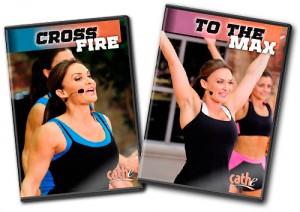
We’ve now pretty much finished editing, authoring, reviewing and testing the Masters for our two new workouts, “CrossFire” and “To The Max“. We should finish final tweaks and corrections today and tomorrow we will send both Masters off to the replicator.
We hope to have both DVDs in stock in about two or three more weeks. We will let you know more once the replicator gives us a firm production date. In the meantime, while you wait we thought we would share with you some of the science behind the making of these two new calorie-crushing high-intensity interval workouts!
Which Type of Workout Burns the Most Fat?
Twenty years ago it was popular to train in the fat-burning zone. Instructors would tell their students to be sure they could talk in complete sentences while doing aerobic exercise to make sure they were primarily using fat as fuel. These “fat-burning” workouts would last a minimum of 30 minutes, while most would last an hour or more.
These days short, high-intensity workouts are all the rage, especially high-intensity interval training like you will see in my new CrossFire and To The Max videos. Research shows you burn more calories and body fat doing high-intensity interval training because of the after-burn effect.
High-Intensity Interval Training: What Length Working Interval is Best?
High-intensity interval training involves short work intervals where you work out at a high intensity for a short time followed by a brief recovery period. This alternating sequence of rest and recovery is repeated for 4 to 30 minutes. Work intervals vary from 30 seconds up to 3 minutes. But did you ever wonder what length of interval is best for maximizing the benefits you get from an interval training workout?
A recent study carried out at the University of Nebraska looked at this issue. When researchers compared the effects of different interval training lengths for cycling on a stationary bike, they found that intervals of 30 seconds carried out at 90% maximum power output were best for maximizing aerobic capacity. When participants exercised for longer intervals or when they pushed the intensity up to 100% of their maximum power output, they didn’t get as much of an increase in mean V02 ( a measure of maximum aerobic capacity) as they did doing 30-second intervals.
Short and intense working intervals of 30 seconds or less seem to have the edge according to this study when it comes to maximizing interval training benefits. Just 15 minutes of high-intensity interval training over a 14-day period using 30-second work intervals was enough to boost endurance in these cyclists by 100%. This is why in my CrossFire and To The Max videos we use a mix of short 30 seconds and 20 seconds (Tabata) high-intensity intervals which help you blast away the calories and fat in the shortest time possible.
Other Benefits of High-Intensity Interval Training
Many people enjoy high-intensity cardio because they get more benefits in less time. The workouts are shorter, but fat-burning is enhanced during the recovery
Interval training is more challenging but less monotonous than spending an hour jogging or cycling at the same intensity. Your body quickly adapts to steady-state workouts, and you stop making gains. Yet, your body doesn’t adapt as readily to high-intensity interval training since you’re pushing it into the anaerobic training zone.
Are There Any Disadvantages to Interval Training?
High-intensity interval training puts more stress on your body, which is why you make greater gains. But if you do it too often, you run the risk of overuse injuries or overtraining. It’s also important to have a certain level of fitness before working out at a high intensity. Do moderate-intensity cardio for 4 to 6 weeks before attempting high-intensity training intervals. Then, do high-intensity intervals only 2 times a week. With high-intensity interval training, your body needs more time to recover than it does with steady state cardio.
Don’t Count Out Steady-State Cardio
Steady-state cardio still has its place. It teaches your body how to more easily use fat stores for fuel and your body doesn’t need as long of a recovery between workouts. Not everyone is suited for interval training. You need to be in good health and at a certain fitness level before maxing out. Steady-state cardio is a good alternative for beginners who aren’t ready for higher intensity training. Steady-state cardio still burns significant calories and fat, although this will usually decrease over time as the body adapts. It also “teaches” your body to better use fat as a fuel source. You may burn more fat as a percentage of total fuel with steady-state-cardio, but you don’t burn as many total calories for the same workout duration or benefit from the after-burn.
If you like the stress-reducing benefits of exercise and enjoy doing something aerobic every day, steady-state cardio may be a better choice. Interval training workouts are more intense and should be done only 2 to 3 times maximum a week.
Finally, if you feel like doing a little steady-state, why not do two high-intensity interval sessions a week and one or more steady-state cardio session? This will diversify your workout and keep your body “guessing.” You don’t necessarily have to choose between the two.
References:
Journal of Strength & Conditioning Research: May 2011 – Volume 25 – Issue 5 – pp 1279-1284.
The University of New Mexico. “Exercise After-burn: Research Update”
Related Articles By Cathe:
The Most Effective Way to Burn More Fat When You Exercise
What Type of Exercise is Best for Improving Aerobic Capacity? Hint: It’s Not Jogging
How to Incorporate Interval Training Into Your Exercise Program
High-Intensity Interval Training: How Intense Does It Have to Be?
5 Common Myths About Interval Training
The Science Behind My New AfterBurn Video and Metabolic Training

